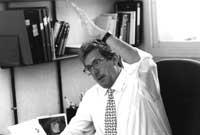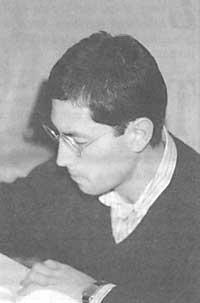Interactions between charged and solid particles
1999/09/01 Pitarke, Jose M. - CIC nanoGUNEko zuzendaria eta Euskal Herriko Unibertsitateko Materia Kondentsatuaren Fisikako katedraduna Iturria: Elhuyar aldizkaria
Over the years one of the objectives of Physics has been to analyze the individual and collective behavior of the particles that constitute the structure and matter of matter. One of the most important sources of information on the properties of matter has been to interact with mobile charged particles of different types of matter, and the need to be able to interpret this type of essays has made it essential to analyze the interactions between matter and charged particles that interact with it, since this type of research, both theoretical and experimental, have played an important role in the development of physics of this century, under the leadership of some of the clearest.
Thus, Rutherford used alpha particles in 1911 to know the structure of the atom and Bohr published in 1913 a pioneering work, calculating the braking force suffered by alpha particles when crossing matter. In the next decade, as soon as Quantum Mechanics developed, mechanico-quantum studies of interaction between matter and charged particles had already begun.
The
realization of theoretical works of the time has led to the publication of numerous works, through theoretical and experimental studies of the interactions between matter and ions. Also, in order to know the structure of matter, electrons have also been used, especially in the case of the design of the electron microscope based on the duplicity of wave particles of the matter predicted by Quantum Mechanics, the field emission microscope and the tunnel microscope.
To analyze the interaction between electrons that form
matter and charged external particles, over the years two main approaches have been made. On the one hand, linear theories have been used, understanding that the disturbance produced by the external particle in the electron gas that makes up matter is small. On the other hand, the solid gel model has been used, considering a uniform positive load background that eliminates the negative average load of electrons from the solid rather than the periodic potential generated by the cores.
Using linear theories, it was discovered that the energy that external moving particles lose by the excitation of electron gas is proportional to the second round of the particle load. However, Barcas experimentally demonstrated that in 1963 the energies lost by the positive and negative pions when crossing the matter are different, demonstrating that the loss of energy is therefore not proportional to the square of the load of the projectile. In fact, in 1989 the energy losses of antiprotons were measured, which for the first time were able to give experimental account of the contribution of energy loss proportional to the projectile load cube by comparing the energy losses of protons and antiprotons.
In
our group we have made a theoretical analysis of the origin of this non-linear contribution from the quantum theory of fields. Lindhard published in 1954 the mechanical-quantum dielectric function that reports the excitations of electrons, using linear theories, and we have obtained expressions that report the quadratic dynamic response of electrons, realizing developments of great order disturbances. We have shown that the difference between the energy losses of the protons and the antiprotons lies in the quadratic response of the electron gas, obtaining results that conform to the expectations of the experiments. Also, taking advantage of the analysis of the quadratic response of the electron gas, we have been able to investigate the nonlinearity of some observable physical phenomena as a consequence of the interaction between charged and solid particles, some of them being: The wake of induced electron density generated by charged particles in the electron gas as they traverse matter, the excitation of electron hollows and double plasmons, and the image potential of charged particles that move through the surface of solids, among others.
Moreover,
in recent years some inexplicable physical phenomena have been experimentally studied within the solid gel model, such as the energy losses of the fast ions channeled in solids and the life times of the excited electrons in solids. In our group we are analyzing the results of this type of experiments, internalizing in detail the structure of the electronic bands generated by the periodic potential of the nuclei. For this we use techniques called 'ab initio', based on the functional theory of time-dependent density.

Gai honi buruzko eduki gehiago
Elhuyarrek garatutako teknologia





